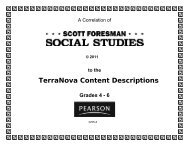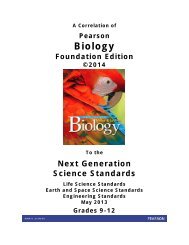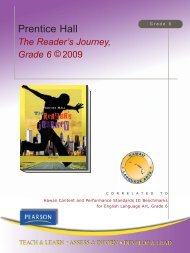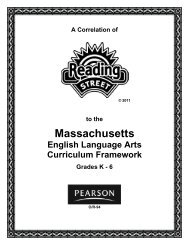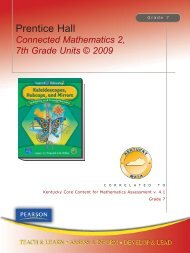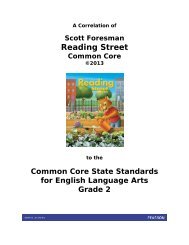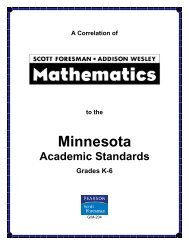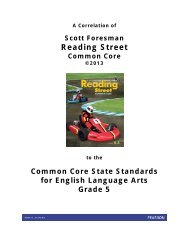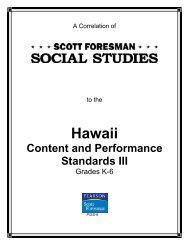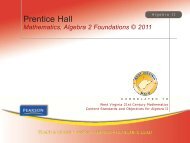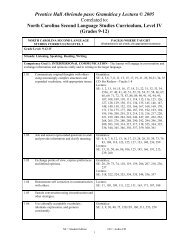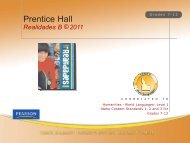Miller & Levine Biology - Pearson
Miller & Levine Biology - Pearson
Miller & Levine Biology - Pearson
You also want an ePaper? Increase the reach of your titles
YUMPU automatically turns print PDFs into web optimized ePapers that Google loves.
HS-ESS2 Earth’s SystemsA Correlation of<strong>Miller</strong> & <strong>Levine</strong> <strong>Biology</strong>, ©2014to the Next Generation Science Standards, May 2013Grades 9-12HS-ESS2 Earth’s SystemsStudents who demonstrate understanding can:HS-ESS2-2. Analyze geoscience data to make the claim that one change to Earth’s surface can create feedbacks that causechanges to other Earth’s systems. [Clarification Statement: Examples should include climate feedbacks, such as how an increase in greenhouse gases causes a rise inglobal temperatures that melts glacial ice, which reduces the amount of sunlight reflected from Earth’s surface, increasing surface temperatures and further reducing the amount ofice. Examples could also be taken from other system interactions, such as how the loss of ground vegetation causes an increase in water runoff and soil erosion; how dammed riversincrease groundwater recharge, decrease sediment transport, and increase coastal erosion; or how the loss of wetlands causes a decrease in local humidity that further reduces thewetland extent.]MILLER & LEVINE BIOLOGY: Lesson 6.1 (pp. 154–157) discusses the effects of agriculture, development, and industry on Earth’s surface.In Lesson 6.2 (pp. 158–165), students learn how poor management of resources can lead to desertification and deforestation. Case Study #3in Lesson 6.4 (pp. 177–179) addresses the causes and effects of climate change.Students analyze geoscience data about how a change to Earth’s surface can cause changes to other Earth systems: Students use a mapof desertification risk to categorize the risk of desertification in their local area (Figure 6–6, p. 159). Students compare data on global landsurfaceair temperature, mean global sea ice, and global sea level (p. 177).HS-ESS2-4. Use a model to describe how variations in the flow of energy into and out of Earth’s systems result in changes inclimate. [Clarification Statement: Examples of the causes of climate change differ by timescale, over 1-10 years: large volcanic eruption, ocean circulation; 10-100s of years:changes in human activity, ocean circulation, solar output; 10-100s of thousands of years: changes to Earth's orbit and the orientation of its axis; and 10-100s of millions of years:long-term changes in atmospheric composition.] [Assessment Boundary: Assessment of the results of changes in climate is limited to changes in surface temperatures, precipitationpatterns, glacial ice volumes, sea levels, and biosphere distribution.]MILLER & LEVINE BIOLOGY: Lesson 3.4 (p. 80) introduces the different types of processes that are involved in biogeochemical cycles. InLesson 4.1 (pp. 96–98), students study some factors that affect climate, including solar output. In Lesson 4.4 (pp. 110–116), students learnabout additional factors that affect climate, including ocean circulation. In Lesson 6.2 (p. 159), students learn how deforestation can affectlocal climates. Case Study #3 in Lesson 6.4 (pp. 177–179) provides details about the effects of human activity on climate change. Lesson19.3 (pp. 553–555) discusses long-term changes in atmospheric composition.Students use a model to describe how variations in energy flow can result in climate change: Students create labeled diagrams to showthat they understand the factors that affect global climate (TE p. 96). Students model the relationship between latitude and solar energy(TE p. 97).HS-ESS2-6. Develop a quantitative model to describe the cycling of carbon among the hydrosphere, atmosphere, geosphere,and biosphere. [Clarification Statement: Emphasis is on modeling biogeochemical cycles that include the cycling of carbon through the ocean, atmosphere, soil, and biosphere(including humans), providing the foundation for living organisms.]MILLER & LEVINE BIOLOGY: The cycling of carbon between the biosphere, atmosphere, hydrosphere, and geosphere is addressed inLesson 3.4 (pp. 82–83). Certain aspects of the cycle are reinforced in Lesson 8.2 (pp. 232–233) and Lesson 9.1 (pp. 251–252).HS-ESS2-7. Construct an argument based on evidence about the simultaneous coevolution of Earth’s systems and life onEarth. [Clarification Statement: Emphasis is on the dynamic causes, effects, and feedbacks between the biosphere and Earth’s other systems, whereby geoscience factors controlthe evolution of life, which in turn continuously alters Earth’s surface. Examples of include how photosynthetic life altered the atmosphere through the production of oxygen, which inturn increased weathering rates and allowed for the evolution of animal life; how microbial life on land increased the formation of soil, which in turn allowed for the evolution of landplants; or how the evolution of corals created reefs that altered patterns of erosion and deposition along coastlines and provided habitats for the evolution of new life forms.][Assessment Boundary: Assessment does not include a comprehensive understanding of the mechanisms of how the biosphere interacts with all of Earth’s other systems.]MILLER & LEVINE BIOLOGY: Lesson 19.1 (pp. 544–545) explains how changes in Earth’s physical environment affect life on Earth andhow biological forces affect Earth’s physical environment. Lesson 22.1 (pp. 636–637) provides the specific example of how the evolution ofplants changed the environment in ways that enabled new species to evolve. In Lesson 21.3 (pp. 610–611) and Lesson 21.4 (pp. 622–623),students learn about the key roles photosynthetic protists and fungi play in support of aquatic and terrestrial life forms.Students construct an argument based on evidence about the coevolution of the biosphere and Earth’s other systems: Students arguehow life would be different on Earth without photosynthetic plants (TE p. 555).The performance expectations above were developed using the following elements from the NRC document A Framework for K-12 Science Education:SE = Student Edition; TE = Teacher’s Edition; LMA = Lab Manual A 19



